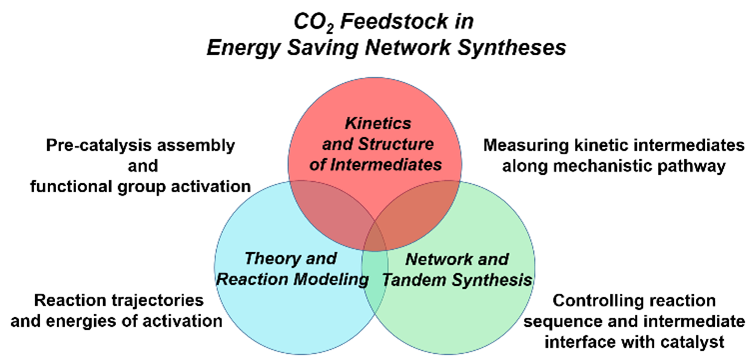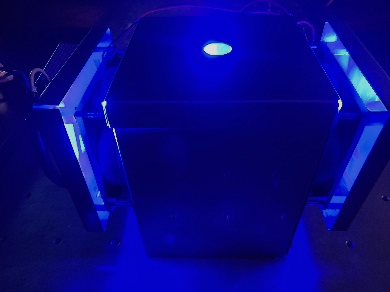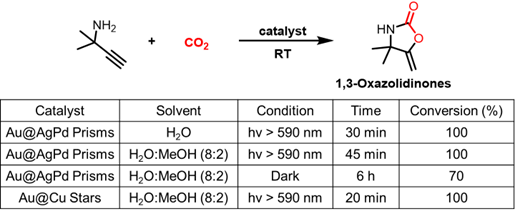 Figure 1. Integrated approach to CO2
Figure 1. Integrated approach to CO2
feedstock transformation into value-added
chemicals with reduced energy.
Our plan is to take advantage of multi-metal synergy for thermal catalytic transformations involving biomass and CO2, as well as plasomonic photothermal heating to drive non-equilibrium reactions otherwise inaccessbile to homogenous catalysts (Figure 1). Hybrid Lewis acid frameworks will be synthesized for these thermal and photothermal transformations, and key reagents with distinct IR features have been chosen to serve as reaction mechanism signatures for transient spectroscopy. In combination with quantum chemical calculations via density functional theory, we will explore the heterogenous catalytic reaction mechanisms for these transformations. Our approach will inform better hybrid designs for CO2 incorporation catalysts that perform network syntheses and reveal a mechanistic understanding for how to combine the properties of different catalyst components within discrete nano-environments.
 Figure 2. Blue LED reactor
Figure 2. Blue LED reactor
for photo-thermal catalysis.
Our approach to driving these reactions photo-thermally will be to first diagnostically measure the photo-thermal heat on the particle surface using a molecular thermometer whose emission band ratio is indicative of the temperature of the surface (Figure 2). We have already synthesized the thermometer, which is a known literature compound. By reacting this complex with simple AgNP surfaces, we will be able to calibrate the emission using a temperature-dependent calibration curve, that during in situ photolysis, will allow us to estimate the surface temperature of the noble element catalyst component.
 Figure 3. Photoinduced CO2
Figure 3. Photoinduced CO2
insertion at Au@M nanocatalysts
for oxazolidinone formation.
Photolysis reactions will be carried out at the plasmon maximum (400 – 500 nm) using our farm of individual 10 W LED photoreactors (67% efficient, 10 diodes with outputs of ~5-15 nm FWHM between 385-740 nm, 5-20 W/cm2, built inside reflective aluminum housings. The thermal surface temperature will be measured via an emission calibration curve(lexc = 266 nm) as a function of solution temperature. Photo-thermal reactions will utilize LED excitation to thermally prepare the catalyst, and lexc = 266 nm excitation and monitoring of the emission band intensity ratio from the thermometer will be the temperature readout. Photo-thermal reactions (Figure 3) will then be optimized using these benchmark parameters.
Related Publications
- The Outliers: Inorganic Radical Reagents for Biological Substrate Degradation, Meghan R. Porter, Joan M. Walker, Jeffrey M. Zaleski, Accts. Chem. Res., (2019), 52(7) 1957-1967.
- Expansion and Contraction: Shaping the Porphyrin Boundary via Diradical Reactivity, Leigh J.K. Boerner, David F Dye, Tillmann Köpke, Jeffrey M. Zaleski, Chem. Rev., (2013), 257(2), 599-620.
- Spin-state Control of Thermal and Photochemical Bergman Cyclization, Leigh J.K. Boerner, Maren Pink, Hyunsoo Park, Amanda LeSueur, Jeffrey M. Zaleski, Chem. Comm., (2013), 49, 2145-2147.
- Photothermal Plasmonic Triggering of Au Nanoparticle Surface Radical Polymerization, Joan M. Walker, Linfeng Gou, Sibraprasad Bhattacharyya, Sarah E. Lindahl, Jeffrey M. Zaleski, Chem. Mater., (2011), 23(23), 5275-5281.
- Conformational and Electronic Consequences in Crafting Extended pi-Conjugated Light-Harvesting Macrocycles, Leigh J. K. Boerner, Shivnath Mazumder, Maren Pink, Mu-Hyun Baik*, Jeffrey M. Zaleski*, Chem. Eur. J., (2011), 17(51), 14539-14551.
- Modulating the Light Switch by 3MLCT-3pp* State Interconversion, Bridgitte R. Spencer, Brian J. Kraft, Chris G. Hughes, Maren Pink, and Jeffrey M. Zaleski, Inorg. Chem., (2010), 49(24), 11333-11345.
- Electronic and Vibrational Analysis of Porphyrazine Liquid-Crystalline Structure: Toward Photochemical Phase Switching, David F. Dye, Krishnan Raghavachari, and Jeffrey M. Zaleski, Inorg. Chim. Acta, (2008), 361, 1177-1186
- Expansion by Contraction: Diversifying the Photochemical Reactivity Scope of Diazo-oxochlorins Toward Development of In Situ Alkylating Agents, Tillmann Köpke, Maren Pink, and Jeffrey M. Zaleski, J. Am. Chem. Soc., (2008), 130(47) 15864-15871.
- Electron Spin Resonance Studies on Electron Beam Irradiated Carbon Nanotubes Dispersed in Styrene-Isoprene-Styrene Block Copolymer, Mircea Chipara, Wendland Beezhold, Timothy Webb, Jeffrey M. Zaleski, Kristina Stephenson, David Dye, and Kin-Tak Lau, Mater. Res. Soc. Symp. Proc., (2005), 851, 211-216.